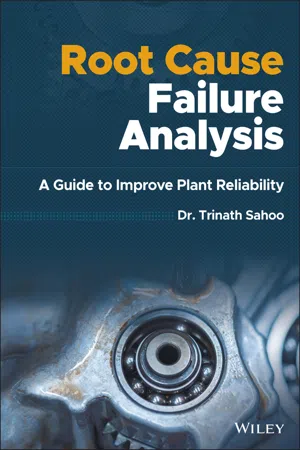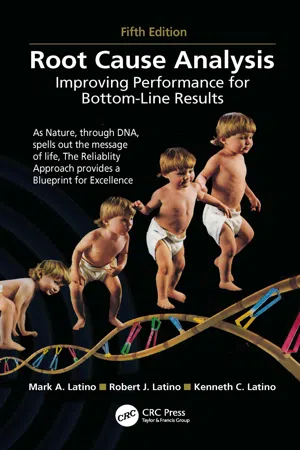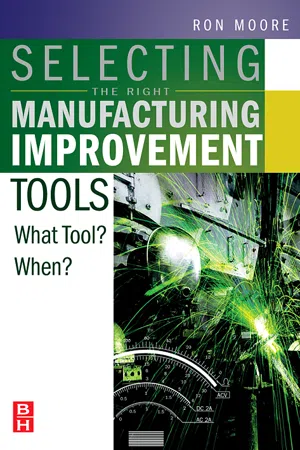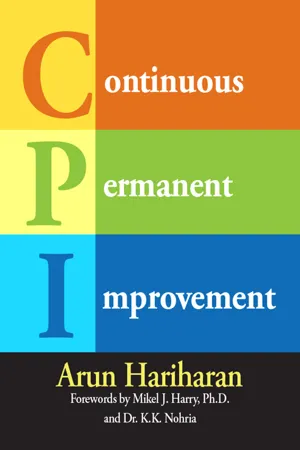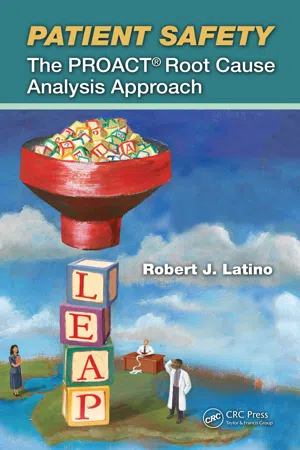Technology & Engineering
Root Cause Analysis
Root Cause Analysis is a systematic process used to identify the underlying causes of problems or issues within a system. It involves investigating the root cause of a problem rather than just addressing its symptoms. By understanding the fundamental reasons for an issue, organizations can implement more effective and sustainable solutions.
Written by Perlego with AI-assistance
Related key terms
1 of 5
11 Key excerpts on "Root Cause Analysis"
- Cheryl Tulkoff, Greg Caswell(Authors)
- 2021(Publication Date)
- Wiley(Publisher)
7 Root Cause Problem‐Solving, Failure Analysis, and Continual Improvement Techniques7.1 Introduction
Root Cause Analysis (RCA) encompasses a category of problem‐solving methods that focus on identifying the ultimate underlying reason of why an event occurred. Root Cause Analysis is a generic term for diligent structured problem‐solving. Over the years, various RCA techniques and management methods have been developed. All RCA activities are problem‐solving methods that focus on identifying the underlying reason of why an undesired issue occurred. RCA is based on the belief that problems are most effectively solved by correcting or eliminating the root causes rather than merely addressing the obvious symptoms. The root cause is the trigger point in a causal chain of events. This trigger point may be natural or manmade, active or passive, initiating or permitting, obvious or hidden. Efforts to prevent or mitigate the trigger event are expected to prevent the outcome or at least reduce the potential for problem recurrence.RCA is a comprehensive analysis method that identifies the chain of physical and human‐related root cause(s) behind an undesirable event. This differs from basic troubleshooting and problem‐solving processes that typically seek solutions to specific, relatively simple difficulties. The undesired event may be a product durability failure, a safety incident, a customer complaint, a quality defect, or a result of human error. RCA focuses the corrective and preventive action (CAPA) efforts on the actions that have the greatest potential impact. It is essential for guiding change management efforts in the most effective and cost‐efficient direction.The goal of RCA is preventing failures before they happen. Prevention can be accomplished via a thorough understanding and analysis of designs, materials, suppliers, and customers. When failures do occur, however, organizations also need methods that enable them to quickly learn from and respond to these events. Effective use of RCA enables the most economical use of resources to achieve these goals. RCA also drives the pursuit of actions most likely to result in success. All companies have constraints on people, money, and time. If an organization doesn't analyze, learn from, and prevent problems, it simply repeats them.- No longer available |Learn more
- (Author)
- 2014(Publication Date)
- Orange Apple(Publisher)
____________________ WORLD TECHNOLOGIES ____________________ Chapter- 6 Root Cause Analysis Root Cause Analysis ( RCA ) is a class of problem solving methods aimed at identifying the root causes of problems or incidents. The practice of RCA is predicated on the belief that problems are best solved by attempting to correct or eliminate root causes, as opposed to merely addressing the immediately obvious symptoms. By directing corrective measures at root causes, it is hoped that the likelihood of problem recurrence will be minimized. However, it is recognized that complete prevention of recurrence by a single intervention is not always possible. Thus, RCA is often considered to be an iterative process, and is frequently viewed as a tool of continuous improvement. RCA, initially is a reactive method of problem detection and solving. This means that the analysis is done after an incident has occurred. By gaining expertise in RCA it becomes a pro-active method. This means that RCA is able to forecast the possibility of an incident even before it could occur. While one follows the other, RCA is a completely separate process to Incident Management. Root Cause Analysis is not a single, sharply defined methodology; there are many different tools, processes, and philosophies of RCA in existence. However, most of these can be classed into five, very-broadly defined schools that are named here by their basic fields of origin: safety-based, production-based, process-based, failure-based, and systems-based. • Safety-based RCA descends from the fields of accident analysis and occupational safety and health. • Production-based RCA has its origins in the field of quality control for industrial manufacturing. • Process-based RCA is basically a follow-on to production-based RCA, but with a scope that has been expanded to include business processes. • Failure-based RCA is rooted in the practice of failure analysis as employed in engineering and maintenance. - eBook - ePub
CAPA in the Pharmaceutical and Biotech Industries
How to Implement an Effective Nine Step Program
- J Rodriguez(Author)
- 2015(Publication Date)
- Woodhead Publishing(Publisher)
9Step 6: part I—Root Cause Analysis
Abstract
Root Cause Analysis (RCA) is a systematic approach to get to the true root causes of our process problems. Without a systematic approach, or the lack of understating how to use the right RCA tool, problems will recur since the true root cause was not identified.RCA is useful in determining the cause(s) of variation so that the appropriate improvement action can be implemented and improvements can be sustained over time. Improvement action that is not focused on the root cause will not be effective, or at least not for very long, so to sustain the improvement over time, the in-depth causes must be found and fixed.The goal of this chapter is to identify a way of conducting an RCA to rationalize and standardize the application of this technique. The following pages are particularly focused on the identification of root causes for problems, so this is the mostly frequent used term, but the same procedure is valid for the identification of root causes for objectives. We will also look at several RCA tools, case studies, and examples of how to use such tools to effectively identify and define the specific factors that may be the causes of the problem. - eBook - ePub
Root Cause Failure Analysis
A Guide to Improve Plant Reliability
- Trinath Sahoo(Author)
- 2021(Publication Date)
- Wiley(Publisher)
3 Root Cause Analysis ProcessThe key to a good Root Cause Analysis is truly understanding it. Root Cause Analysis (RCA) is an analysis process that helps you and your team find the root cause of an issue. RCA can be used to investigate and correct the root causes of repetitive incidents, major accidents, human errors, quality problems, equipment failures, production issues, manufacturing mistakes, and can even be used proactively to identify potential issues.The key to successful Root Cause Analysis is understanding a process or sequence that works. The effect is the event – what occurred. A cause is defined as a set of circumstances or conditions that allows or facilitates the existence of a condition an event. Therefore, the best strategy would be to determine why the event happened. Simply put, eliminating the cause or causes will eliminate the effect.What is Root Cause Analysis
Root Cause Analysis is a logical sequence of steps that leads the investigator through the process of isolating the facts or the contributing factor surrounding an event or failure. Once the problem has been fully defined, the analysis systematically determines the best course of action that will resolve the event and assure that it is not repeated. A contributing factor is a condition that influences the effect by increasing the probability of occurrence, hastening the effect, and increasing the seriousness of the consequences. But a contributing factor will not cause the event. For example, a lack of routine inspections prevents an operator from seeing a hydraulic line leak, which, undetected, led to a more serious failure in the hydraulic system. Lack of inspection didn’t cause the effect, but it certainly accelerated the impact. - Ricky Smith, R. Keith Mobley(Authors)
- 2011(Publication Date)
- Butterworth-Heinemann(Publisher)
Finally, the application of systematic processes for focusing resource deployment supports a due diligence approach to physical asset management. Projects having the largest potential impact on the corporation weighted toward safety and environmental integrity become the most critical. Projects with the potential to deliver the maximum benefit to the company by mitigating risk are identified for equipment reliability improvement strategies.5.5. Root Cause Analysis
Root Cause Analysis (RCA), also called root cause failure analysis (RCFA), is the systematic evaluation of problems to find the basic causes that, when corrected, prevent or significantly reduce the likelihood of a recurrence. These basic causes are called root causes. It is important to realize that most problems have more than one contributing cause, and if one of these contributing causes were eliminated, the problem would not recur.Unexpected equipment failures are not normal and should not be tolerated. Equipment problems not determined sufficiently and solved only well enough to get the equipment back up and running will return; therefore, the cause of the failure must be understood and fixed, not just the failed equipment.A structured RCA process is needed to make sure the true root cause(s) of a problem are understood instead of the more obvious symptoms. If the solution to the problem addresses the symptoms, obviously, the problem will reappear at some point in the future or other problems will be created by the implemented solution.Every failure affords an opportunity to learn. Ignoring these opportunities means missing the chance to extend equipment life, decrease repair frequency, and improve profitability. RCA has four fundamental steps:- eBook - ePub
Root Cause Analysis
Improving Performance for Bottom-Line Results, Fifth Edition
- Mark A. Latino, Robert J. Latino, Kenneth C. Latino(Authors)
- 2019(Publication Date)
- CRC Press(Publisher)
2Introduction to the Field of Root Cause Analysis
What Is Root Cause Analysis?
What a seemingly easy question to answer, yet no standard, generally accepted definition of Root Cause Analysis (RCA) exists in the industry today, of which we are aware. Technical societies, regulatory bodies, and corporations have their own definitions, but it is rare to find two definitions that match. For the sake of having an anchor or benchmark definition, we will use the definitions provided by the Department of Energy (DOE) Guideline entitled “Root Cause Analysis Guidance Document (DOE-NE-STD-1004-92).”1In the DOE document referenced above, the following is cited:The document goes to say that every root cause investigation and reporting process should include the following five phases:The basic reason for investigating and reporting the causes of occurrences is to enable the identification of corrective actions adequate to prevent recurrence and thereby protect the health and safety of the public, the workers and the environment.- Data collection
- Assessment
- Corrective actions
- Inform
- Follow-up.
When we look at any investigative occupation, these five steps are critical to the success of the investigation. As we progress through this text, we will align the steps of the PROACT® - eBook - PDF
Selecting the Right Manufacturing Improvement Tools
What Tool? When?
- Ron Moore(Author)
- 2011(Publication Date)
- Butterworth-Heinemann(Publisher)
285 Root Cause Analysis 14 A pessimist sees the difficulty in every opportunity; an optimist sees the opportunity in every difficulty. Winston Churchill Introduction Robert Nelms’ has said that Root Cause Analysis (RCA) begins by examining catastrophic events, but ends up looking at the small things that cause the big ones. This lends credibility to the need to get the basics right first. It’s the confluence of many little things done poorly that usually results in some big, bad thing happening. And, according to William Salot, RCA is any evidence-driven process that, at a minimum, uncovers underlying truths about past adverse events, thereby exposing opportunities for making lasting improvements. Let’s explore this further. There are many reasons why problems occur. For each reason, there are often many underlying reasons why the original event happened, and indeed in many cases a complex event tree can be created that describes at each level the additional underlying reasons for the previ-ous event. As Nelms observed, catastrophic events more often than not result from the confluence of a number of small actions that ultimately led to the catastrophe. If any one of the actions that were a contributor to the confluence of circumstances had been eliminated earlier, the cata-strophic incident would not have occurred. Fortunately this complexity 286 S e l e c t i n g t h e R i g h t M a n u fac t u r i n g I m p rov e m e n t minimizes the risk of major accidents or incidents. Unfortunately, it makes them more difficult to prevent, since any one event may seem innocuous or unimportant. RCA is a way of identifying root causes so that action can be taken to prevent them in the future. Figure 14-1 provides a simple logic chart for doing a RCA. 1 The benefits of using a root cause approach are clear: ■ It saves time by tackling the root cause first, not symptoms. - eBook - ePub
- Arun Hariharan(Author)
- 2014(Publication Date)
- ASQ Quality Press(Publisher)
no.” RCA—THE EPITOME OF LEANThe beauty of Root Cause Analysis lies in its simplicity. As a former Toyota executive said with some sarcasm, “We have a very sophisticated technique. It is called five why. We ask why five times” (Likert 2004).One could say that RCA is the epitome of Lean. What other technique is so simple to understand, yet so big on results? No continuous improvement is possible without RCA. Doubtless, there are certain requirements to obtain real, substantial, and sustained results from RCA. These have been dealt with in detail in this chapter, and clearly, they mostly have to do with discipline and the right mind-set. For organizations (or individuals) that have this discipline and mind-set, defects and complaints become opportunities that propel them forward on the journey toward excellence!CAN PROBLEMS BE PREVENTED BEFORE THEY EVER OCCUR?So far in this chapter, we have talked about how to use a defect or problem, after it occurs at least once, to get to the root cause and prevent the problem from happening again. In a few of the companies that I worked with, somebody would ask, “But do we always have to wait for a problem to happen, and then prevent it? Can’t we anticipate what could go wrong and prevent it even before it happens?” A very useful question, and our experience on this is as follows.These companies used a simple practice of calling people involved in the process into a meeting and trying to identify everything that could go wrong. In other words, what were the risks or “failure modes” in the current process—for the customer or for regulatory compliance? In addition to identifying potential failure modes, answers to the following questions would also be discussed: Is there a way to do this process at a lower cost? Is there a way we could do this more efficiently? Often, some opportunities for improving the process would be identified this way. We used a simple two-way matrix (see Figure 21 ) to prioritize what improvements or process changes should be done immediately. Top priority was given to changes that would bring higher benefits, or carried - eBook - PDF
Patient Safety
The PROACT Root Cause Analysis Approach
- Robert J. Latino(Author)
- 2008(Publication Date)
- CRC Press(Publisher)
71 7 The PROACT ® Root Cause Analysis (RCA) Methodology I will start this chapter off with a pet peeve of my own that I want to dispel for you all. When I am reading any text and I see the ® (registered trademark) symbol, it makes me suspicious about the motives of the author. This would insinuate some-thing that is proprietary and that the author is marketing. I do not like paying good money for a book that turns out to be a sales pitch and does not provide me value. Now let me explain my rationale for using the ® in this chapter. I find it almost impossible to write a text on “Root Cause Analysis” or RCA because there is no uni-versally accepted standard as to what an RCA is. There are no regulations that can mandate that a certain type of RCA be used; only what the desired outcomes (in terms of information) should be. Because of this lack of clarity of what RCA is, prac-titioners define whatever they are doing to solve problems as RCA. In essence, the standalone term RCA is diluted to the point of being useless and misleading. RCA is simply a noun in today’s environment. The only way for people to get value from RCA is to use a specific methodol-ogy in which they have had success. These “specific” methodologies represent the various proprietary brands on the market. These brands are simply adjectives of the noun RCA. My firm developed one of these brands, referred to as PROACT®. This is an RCA process that has been used successfully all over the world since 1985. To protect the uniqueness of our brand of RCA, we must formally register it to prevent others from using the same name. So now you know why we have had to become a victim of our own pet peeve! The term PROACT has recently come to light to mean the opposite of react. This may seem to be in conflict with PROACT’s use as a Root Cause Analysis (RCA) tool. From this point on, the term RCA shall be used as being consistent with the PROACT RCA methodology, which is simply a brand of RCA. - Available until 4 Dec |Learn more
Patient Safety
Investigating and Reporting Serious Clinical Incidents
- Russell Kelsey(Author)
- 2016(Publication Date)
- CRC Press(Publisher)
2 Root Cause Analysis: Background and contextTwo phenomena intersected in the 1950s and 1960s that were to have a profound influence upon patient safety in the healthcare sector – the emergence of the Japanese motor industry and the massive expansion of the aviation industry. It is within these two industries that the concept of Root Cause Analysis as a means of identifying and solving problems arose.The origin of Root Cause Analysis is important. It explains both why it is so potentially useful but also why it often fails to work well in healthcare. It is salutary for clinicians and service managers to realise that while the processes and techniques we use to manage clinical encounters are vested in many years of professional clinical experience and scientific development, most of the processes and techniques that are used to manage the logistics and in particular the governance of healthcare have been adopted from other industries.Sakichi Toyada, the founder of Toyota Motor Corporation, is credited with developing formal techniques for improving production quality, including the ‘5 Whys’ technique that was used to analyse production failings to find the ultimate root cause of failure. Researchers in the emerging Japanese industrial giants, including Kaoru Ishikawa working for the Kawasaki company – famous for his ‘fishbone’ diagram – developed the concept of total quality management (TQM). Arising from these concepts and processes come other industrial quality-improvement processes increasingly familiar in healthcare such as Six Sigma and lean management. At the same time, in the United States the responsibility for investigating aviation safety was delegated to National Aeronautics and Space Administration (NASA) and scientists there started to develop formalised techniques for incident investigations. The results of the use of formalised investigation aimed at learning from identified errors was striking: - eBook - PDF
Reliability Engineering
A Life Cycle Approach
- Edgar Bradley(Author)
- 2016(Publication Date)
- CRC Press(Publisher)
Categorisation methodologies, such as checklists, provide a hierarchical outline, checklist or ‘Cause Tree’ from which a root cause is chosen. Through discussion and consensus, a solution is attached to the defined root cause and is implemented. Focusing on the root cause is a highly ineffective problem solving strategy because it prevents us from under� standing all the (possible) causal relationships. Causal Relationship Methods Causal relationship methods are based on the premise that everything that happens has a set of very specific causes and that, by knowing these causes, we can control them and hence find effective solutions. While a very sound basis, these methods are only as effec� tive as the tools provided. Fault trees and the Apollo Event Tree method are two such techniques. The Nature of Failure The cases presented later in this chapter include the complex (Chernobyl), the simple (Flixborough and the Hyatt Regency Hotel) and the intermediate (Challenger and Piper Alpha). If we study these and other cases, we will notice certain patterns appearing. Faults can be attributed to any combination of design, maintenance, operational and manage� ment errors. There are lessons to be learned for anyone engaged in the design, mainte� nance, operation or management of engineering systems. In one of the cases, the Embraer aircraft crash, the student must investigate the case himself, using the techniques pre� sented earlier. The approach taken by the author for all these cases is that all errors are human errors – the plant failed because someone designed it incorrectly, maintained it incorrectly or 177 Incident Investigation or Root Cause Analysis whatever. The electrical, mechanical, chemical, civil and electronic hardware is neutral. It is not emotional, it does not make mistakes and it does not go out on strike. The author has in fact analysed many cases of failure, and the results are presented in Table 5.5.
Index pages curate the most relevant extracts from our library of academic textbooks. They’ve been created using an in-house natural language model (NLM), each adding context and meaning to key research topics.



